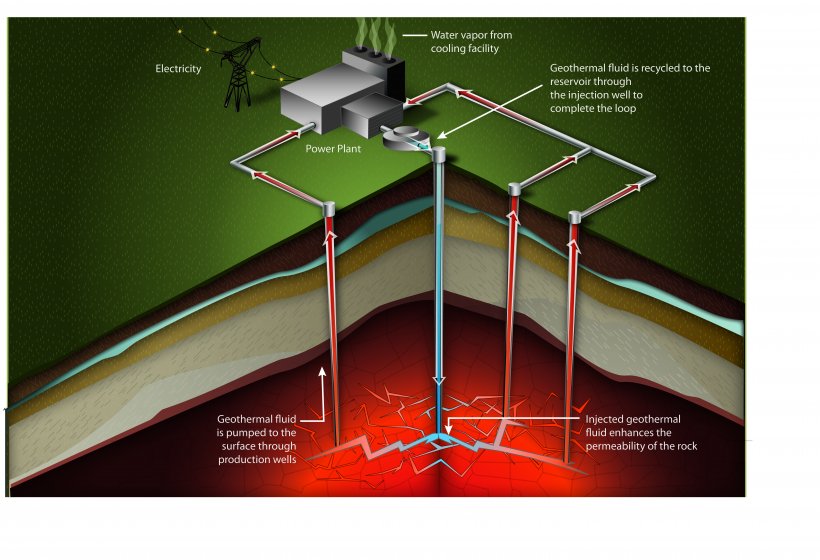Over the past few months, both the popular press and specialty publications in the renewable energy field have been abuzz with excitement about the commercialization of a new geothermal energy technology by a Houston-based startup company, Fervo Energy. The approach, called Enhanced Geothermal Systems (EGS), uses hydraulic fracturing (fracking) techniques developed by the oil and gas industry to access geothermal energy at locations where hot underground water does not reach the Earth’s surface. The Fervo Energy breakthrough gained wide notice in part because the US Department of Energy (DOE) has long promoted the potential of the technology. Fervo’s accomplishment is real enough; later this year, the company will begin supplying small amounts of EGS-derived electricity to Google data centers in Nevada. Glowing reports by some sources notwithstanding, EGS has significant downsides and requires much more development before it might make a difference at scale. As we will see, the ardent attention paid to EGS also belies the availability of a much more promising and environmentally friendly geothermal technology with great potential to enhance the resilience of the electricity grid.
Today, most geothermal energy is used to produce electricity in regions where underground heat is visibly carried to the Earth’s surface, at hot springs and geysers, for example. In the US, this resource is almost entirely concentrated in the Western states. At these geothermal sites, steam and hot water at temperatures of 100-150°C or higher can be easily extracted and used to drive electricity turbines, and the cooler water that emerges is injected back into the ground at a separate, nearby location. The geothermal power switch, so to speak, is always in the “on” position, so the power plants can operate a very high percentage of the time without the intermittency typical of wind and solar arrays. This makes geothermal electricity ideal for providing baseload power to the grid. However, the rarity of this easily-tapped resource has so far limited its contribution to less than one-half of one percent of the nation’s electricity generating capacity. Now EGS proponents want to tap more broadly into the Earth’s ubiquitous underground heat by creating large artificial reservoirs through which water can be circulated. Existing drilling technology may allow accessing this heat resource to depths of four miles or more, where temperatures may reach 300°C or higher.
EGS is currently very expensive, but the DOE is promoting it with an optimistic “Enhanced Geothermal Shot” target, which aims to reduce costs 90% within a dozen years, making it competitive with other renewable energies. DOE is also funding a large EGS demonstration project in Utah, the Frontier Observatory for Research in Geothermal Energy (FORGE), with the hope of developing new drilling technologies attractive to the private sector. If these efforts bear fruit, the DOE estimates that geothermal power plants could provide about 10% of US electricity generation by 2050, a very substantial increase compared with today. The technology might be limited to the Western US, though, because underground temperatures in the central and eastern parts of the country are much cooler, even four miles down. Higher water temperatures increase the efficiency of electricity generation, making the ventures more commercially viable.
Success in this endeavor will not come easily. In conventional fracking, mixtures of water, sand and chemicals are injected into shale formations at high pressure, causing the rock to crack and yield much more oil and gas than conventional approaches. Fracking includes horizontal drilling: after a well reaches a depth of several miles, the drill turns and proceeds horizontally for a mile or more. But there is no circulation of the injection mixture, which flows back up the drilling pipe before oil and gas emerge. In contrast, EGS requires drilling two deep wells at an appropriate spacing, and then joining them in the deep underground to create a loop for circulation of injected water. This appears to be quite challenging and site-specific, making each new project a unique endeavor. Poorly understood local geology will likely impact each attempt; for example, it is not clear that the deep Earth will always resupply heat at the same rate that it is taken away. And EGS carries many of the same potential risks as oil and gas fracking: induced earthquakes, contamination of groundwater, ecological effects at drilling sites and human health impacts in frontline communities. Proponents argue that the technology will be cleaner than oil and gas fracking, which is a reasonable claim once operations start, but appears much less credible in what is sure to be a lengthy development phase.
The pursuit of EGS reflects a particularly American approach to energy development: more is better, dominate by any means necessary, and don’t be concerned with the consequences. This mentality drove the oil and gas fracking industry, and it is pretty clearly on display with EGS, too. Of course, we do need to generate a great deal of new carbon-free electricity to replace coal and natural gas, but precisely how much more depends on demand. And this is where distinctive low-temperature geothermal energy innovations are poised to make a difference. Storing excess heat underground in the hot months, and recovering it when temperatures are low, will reduce electricity demand for heating, cooling and hot water in homes and businesses. The technology, dubbed Underground Thermal Energy Storage, is well developed in Europe and may be ready to expand in the US. It is much less costly and has fewer environmental impacts than EGS. Deploying UTES at scale could reverberate widely, reducing the scale and scope of necessary new electricity generation, transmission infrastructure and battery storage across the country.
UTES works because the shallow subsurface of the Earth maintains an approximately constant temperature year-round, regardless of the ambient above-ground temperature. The basic technology is simply a ground source heat pump, consisting of a compressor that circulates a refrigerant inside the pump, coupled to an inside heat exchanger. In hot months, the shallow subsurface is much cooler than the air, and the heat exchanger draws heat out of the building and into the refrigerant. In turn, the refrigerant interfaces with a second heat exchanger, which transfers the building heat to a fluid in a closed loop that penetrates into the cool ground, where the inside heat is ultimately delivered. The process is reversed in cold months, when the subsurface is the heat source. An alternative heat pump design is the open loop, which eliminates the exterior-facing heat exchanger and refrigerant, directly using groundwater to interface with the internal heat exchanger. Of course, this requires an adequate supply of fresh water.
In urban and suburban settings, where UTES is mainly applied, individual buildings are linked to form a district heating and cooling system. Each building is connected by underground pipes to a central energy station, which circulates heating or cooling water throughout the district. The energy station mediates heat transfer between the entire district and the deeper subsurface, either through an open loop system that circulates into an underground aquifer (aquifer thermal energy storage; ATES) or a closed loop system that transfers heat through pipes extending into the solid earth (borehole thermal energy storage; BTES). Districts might consist of a suburban neighborhood, a collection of hospital buildings, a company or university campus, or some other configuration. About 3500 ATES systems are functioning now in the Netherlands, where the technology is best developed. Experience there has shown that buildings connected to ATES typically reduce their energy use by 50%. Since buildings are responsible for about 30% of energy use and 27% of carbon emissions worldwide, the potential climate benefits are clearly enormous. The technology will be effective even after natural gas is phased out in buildings, since it will reduce demand for green electricity, lowering overall system costs and improving resiliency to extreme weather.
Designing and constructing well functioning district heating and cooling systems demands a solid understanding of the local geology, groundwater characteristics, and subsurface heat flows. For seasonal energy storage, separate cold and warm reservoirs must be maintained at distinct positions in an underground aquifer (for ATES) or in the solid soil and rock medium (for BTES). Typically, boreholes or aquifers are located 500-1000 feet below the surface – far shallower than with EGS but nonetheless still requiring some substantial effort to properly harness. It is also essential not to overload the capacity of the system by withdrawing or introducing too much heat, which degrades effectiveness by reducing the temperature difference between the surface and subsurface environments.
What limits the deployment of ATES and BTES systems in the US? In a recent webinar sponsored by the US Geological Survey, Mark Worthington, founder of a US company that designs and installs these systems, identified a number of barriers that need to be addressed. Unlike the Netherlands and nearby countries, which possess relatively uniform subsurface geology and abundant aquifers, the geology of the shallow subsurface in the US is extremely diverse. This adds to the upfront costs, since preliminary design and investigation, including computer modeling of groundwater and heat flows, has to be more thorough. There is also a general lack of awareness about the technology, with few established practitioners or example projects for new initiatives to draw on. Finally, the projects are significant enough in scale to require popular support, especially in urban environments where open space is at a premium, and the necessary drilling and potential for subsurface contamination may generate opposition if the local community is not involved.
Although the US remains far behind Europe in its beneficial use of the shallow subsurface resource, a number of recent initiatives show that the tide is turning. New tax credits in the federal Inflation Reduction Act are inclusive of geothermal energy, and will make private investment more attractive. Direct action is also beginning at state and community levels. Last year, New York Governor Kathy Hochul signed a key law, the Utility Thermal Networks and Jobs Act, authorizing energy utilities to distribute and sell thermal energy in underground pipelines. This legislation, perhaps the first of its kind, facilitates construction of the infrastructure for district geothermal heating and cooling. Similar legislation is currently being drafted in Maryland. These initiatives open green income opportunities for natural gas utilities in both states, offering a much needed new business model. New York and Maryland utilities will be able to follow the pioneering efforts of Eversource, the local natural gas utility in Framingham, Massachusetts, which broke ground in June on a networked, closed loop geothermal system that will connect 40 buildings to the subsurface. The Vermont Natural Gas utility is also on the leading edge of diversification and will likely follow suit soon (Earthward, 20 July). As these initiatives build, more utilities in states with healthy climate laws are likely to follow suit, as their efforts will comply with decarbonization mandates.
EGS and UTES exemplify sharply opposing dimensions of the green energy transition. EGS is a highly ambitious, technology-dependent, top-down effort that is developing largely out of public view, while UTES represents a modest, low-technology approach using established methods, but heavily dependent on productive engagement among utility companies, investors, consumers, and environmental and social justice advocates. How these initiatives unfold in the coming years will be a matter of intense interest and import.
______________________________
https://www.energy.gov/eere/geothermal/enhanced-geothermal-shot
https://www.energy.gov/sites/default/files/2019/06/f63/GeoVision-full-report-opt.pdf
https://www.wired.com/story/a-vast-untapped-green-energy-source-is-hiding-beneath-your-feet/
https://rmi.org/clean-energy-101-geothermal-heat-pumps/
https://underground-energy.com
https://pure.tudelft.nl/ws/portalfiles/portal/104770896/1_s2.0_S0306261919305197_main.pdf
https://www.iea.org/energy-system/buildings
https://pangea.stanford.edu/ERE/pdf/IGAstandard/SGW/2023/Goetzl.pdf
https://www.phcppros.com/articles/15882-new-yorks-thermal-energy-networks-law

